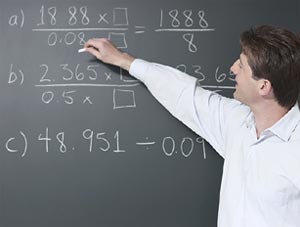 Before we can really understand more complex mathematics it is
essential to go back and think about numbers. We all learned about
numbers as a kid. Numbers arise from counting objects; we could have
no trees, one tree, two trees etc…
Before we can really understand more complex mathematics it is
essential to go back and think about numbers. We all learned about
numbers as a kid. Numbers arise from counting objects; we could have
no trees, one tree, two trees etc…
Numbers can be represented along a one dimensional line starting at zero we might have a line that looks like this:
0 1 2 3 4
On the number line, numbers which are to the left are less than numbers to the right. We use the symbol “<” to indicate that one number is smaller than another number, and we use the symbol “>” to represent that one number is larger than another number.
Example
3 > 2 is used to represent “three is greater
than two”
5 < 9 is used to represent “five is less than nine”
We call the set of counting numbers whole numbers {0, 1, 2, 3, 4,
5, …}
Note that there is some disagreement about weather or not zero
should be include din this set of numbers.
Not only do we have positive numbers we also have negative numbers. Negative numbers are one the challenges many people have in mathematics. A negative number is any number whose value is less than zero. To represent a negative number we place a minus sign in front of the number.
Example
- 2
- 4/5
- 6.28
| LESSON 1 |